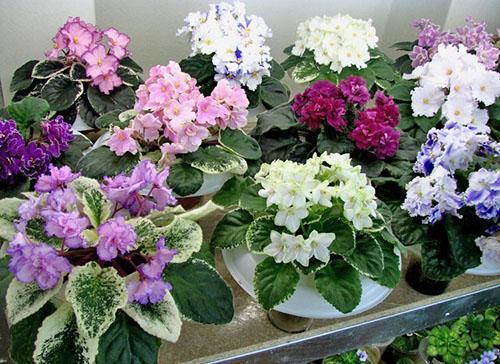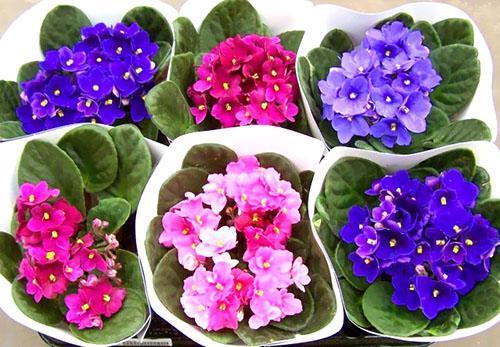Caring for a violet at home
 Violet has taken its rightful place not only on the windowsills. There is a club of lovers of these plants who breed fabulous beauty hybrid specimens, organize exhibitions and share their experience of caring for violets at home. The species range is represented by thousands of varieties registered and still in breeding, many known, but not included in the register. Often these are randomly selected hybrids.
Violet has taken its rightful place not only on the windowsills. There is a club of lovers of these plants who breed fabulous beauty hybrid specimens, organize exhibitions and share their experience of caring for violets at home. The species range is represented by thousands of varieties registered and still in breeding, many known, but not included in the register. Often these are randomly selected hybrids.
On this topic:violets - how to care to bloom?
Varieties of violets

Violets and related beliefs and folk signs
 When growing violets at home, it is believed that these plants strengthen the material condition of the inhabitants and their health.
When growing violets at home, it is believed that these plants strengthen the material condition of the inhabitants and their health.
Violets are credited with the ability to expel ants from their homes. They also create a field of luck in the house and calm unbalanced people. If the violet dies, it is believed that she took on the owner's illness. And if someone from the household is sick, then the violet also withers, sharing the torment of the person.
Such signs make caring for a plant that has settled in the house responsible, since a blooming violet will be an indicator of a healthy family.
The color of the inflorescences also matters:
- purple flowers are an indicator of love and understanding;
- blue flowers thrive in a creative atmosphere;
- reds warn against excessive commercialism;
- white color brings harmony, removes negativity and suffering;
- pink flower on the window of a lonely person calls for a couple.
A delicate flower requires a caring attitude towards itself, not only to poke a finger into the ground, but to stop, talk, lovingly touch the leaf. The unloved flower will wither and die from the lack of a simple morning greeting. You can rid the flower of negative energy by turning the planter from time to time with the other side to the light.
Violet planting and care at home
 If you decide to get a violet, then you should take into account its preferences. The flower loves bright lighting, but does not tolerate direct sunlight. Violet loves moist soil, but without stagnant water, does not like excessive air humidity and does not tolerate spraying a leaf blade. It can be cleaned only under the shower, but after rare procedures a dry plant should be taken out, without droplets of water on the leaves. Water for irrigation should always be warm and settled. Moderate is considered comfortable and favorable for the root system. watering through the pallet.
If you decide to get a violet, then you should take into account its preferences. The flower loves bright lighting, but does not tolerate direct sunlight. Violet loves moist soil, but without stagnant water, does not like excessive air humidity and does not tolerate spraying a leaf blade. It can be cleaned only under the shower, but after rare procedures a dry plant should be taken out, without droplets of water on the leaves. Water for irrigation should always be warm and settled. Moderate is considered comfortable and favorable for the root system. watering through the pallet.
The violet does not like drafts from a window as well as warm air from a heater, a fan. She can not stand the lack of love and tranquility in the house and inattention to herself. If the desire to have a violet has only become stronger, then we are preparing to receive a new family member.
Ground requirements
 Caring for indoor violets begins with preparing the correct substrate and container for the plant. For planting, an acidic composition is taken, including peat, dried sphagnum moss, leafy earth, sand and charcoal.
Caring for indoor violets begins with preparing the correct substrate and container for the plant. For planting, an acidic composition is taken, including peat, dried sphagnum moss, leafy earth, sand and charcoal.
Moreover, moss and coal should not be more than 10% of the total composition of the main ingredients:
- peat - 3 volumes;
- sheet land - 5 volumes;
- coarse river sand - 1 part.
Experts advise adding perlite and vermiculite to peat, which help to retain moisture in light soil. Poor composition requires nutritional addition as it grows. Once a year, a humate solution is added in winter; in spring and autumn, mineral dressings are made with a special liquid fertilizer for Saintpaulias. The condition is to prevent overfeeding, the soil must always remain lean.
Transplant capacities and timing
 Growing violets at home has no trifles. In order for a clod of earth not to sour, it must be sufficient for the development of roots, but without excesses. So, for an adult plant, a glass with a height and diameter of 10 cm is quite enough, while the lower part of it should consist of half of the drainage filling.
Growing violets at home has no trifles. In order for a clod of earth not to sour, it must be sufficient for the development of roots, but without excesses. So, for an adult plant, a glass with a height and diameter of 10 cm is quite enough, while the lower part of it should consist of half of the drainage filling.
Until the root system fills the pot with soil, the plant will not bloom. For dilution, the first pan can be 6 cm in diameter. The drainage hole should be large enough everywhere. The plant is transplanted every three years, while it is not necessary to change the capacity of the pot, you can only change the ground, carefully peeling the roots as much as possible.
Reproduction and transplantation of violets
 Planting and caring for a violet at home begins with getting a young plant. Reproduction can be carried out:
Planting and caring for a violet at home begins with getting a young plant. Reproduction can be carried out:
- leaves;
- cuttings;
- seeds;
- rooting of peduncles.
 The simplest, often used method is leaf rooting. Before rooting, the cut of the resulting leaf should be updated, while making it diagonally across the leaf with a disinfected instrument and lowering the cut into water until callus and roots are formed.
The simplest, often used method is leaf rooting. Before rooting, the cut of the resulting leaf should be updated, while making it diagonally across the leaf with a disinfected instrument and lowering the cut into water until callus and roots are formed.
With the length of the roots 4-7 cm, the leaf can be rooted, covered from above from excessive evaporation and wait for the results to appear. The small plants that appear are planted in separate containers as they grow up. Such plants will bloom with good care in a year.
Hybrid violets, called chimeras, can only be propagated by stepchildren and peduncles, which transmit maternal qualities. The stepson can be separated from the main outlet with an awl and immediately rooted in a peat tablet.
 When transplanting plants, make sure that the root system is healthy. The roots of the plant are white, lively and completely fill the container. When taken out of the conical planter, they retain its shape. This is the basis of one of the methods of watering the plant, for which an external pillow soaked through a filter is created. To do this, a well-formed plant is arranged in a large pot with a damp substrate in a special nest.
When transplanting plants, make sure that the root system is healthy. The roots of the plant are white, lively and completely fill the container. When taken out of the conical planter, they retain its shape. This is the basis of one of the methods of watering the plant, for which an external pillow soaked through a filter is created. To do this, a well-formed plant is arranged in a large pot with a damp substrate in a special nest.
 Root revision is to remove all brown dead roots. Only light living healthy roots are left. With this treatment, the plant can be washed in water, and the roots can be straightened and planted in a prepared pot. If the root rot is eaten, clean the plant to living tissue, sprinkle with activated charcoal and dry it, and then re-root it in water or in moss, which has bactericidal properties.
Root revision is to remove all brown dead roots. Only light living healthy roots are left. With this treatment, the plant can be washed in water, and the roots can be straightened and planted in a prepared pot. If the root rot is eaten, clean the plant to living tissue, sprinkle with activated charcoal and dry it, and then re-root it in water or in moss, which has bactericidal properties.
Plants do well in summer at temperatures up to 25 0, in winter at 18-20. Air dryness should be about 50%. The plant requires a year-round day length of at least 10 hours, and during flowering periods, local illumination with fluorescent lamps.
 If watering is carried out through the sump, then the excess water should be drained. When watering into a pot, do not wet the leaves. In the summer, they water a little every day, in the winter - 2 times a week. A young plant will bloom in a year, not earlier.
If watering is carried out through the sump, then the excess water should be drained. When watering into a pot, do not wet the leaves. In the summer, they water a little every day, in the winter - 2 times a week. A young plant will bloom in a year, not earlier.
If proper care is taken, a photo of violets at home will be a reward.
 Plants usually bloom for about 2 months, while flowers that have faded and have lost their decorative effect need to be plucked out.
Plants usually bloom for about 2 months, while flowers that have faded and have lost their decorative effect need to be plucked out.
The plant will not bloom if the conditions for its maintenance are violated or parasites or diseases are introduced into the bush.You need to know enemies by sight and be able to deal with them.
Violets are tender and heat-loving plants. Caring for a violet at home means having enough light. If you don't have well-lit places in your house, it is better not to plant violet flowers, since the growth and flowering of Saintpaulias depends on the amount and quality of lighting.
I love violets very much, but somehow they do not take root in my house! Thank you so much for the advice on growing violets in your home. I think I need to try to put them in a brighter place, suddenly this time everything will work out!